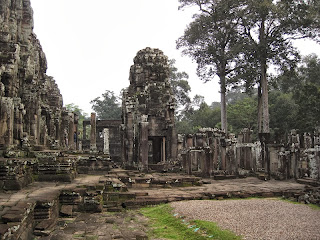October 13 - 16
We arrived in Cambodia on Sunday, October 13th and checked into our hotel, Memoire d'Angkor.
We left early in the morning the next day to catch the sunrise at Angkor Wat. Angkor Wat is just one of the many temples in Ancient Angkor. Angkor Wat is the world's largest religious monument, and the grandest of all the Khmer temples, dating back to early 12th century. It's actually an ancient city all its own from the moat to the central towers and everything in between. The moat represents the mythical oceans surrounding the earth and the towers represent the mountain ranges that surround the home of the gods.
Some pictures from our Angkor Wat sunrise...
As you walk up the pathway to the temples, there are lakes on either side. These are the famous lake reflection shots
Walking into the temples
This is where one of the scenes from Tomb Raider was filmed. They shot a bunch of scenes at many of the temples of Angkor during the filming of the movie.
Inside the temple in the center of the 4 towers
These carvings in the side of the walls are called Asparas, celestial dancers who entertain the gods.
One of the many corridors within Angkor Wat.
One of the four stone basins in the "cruciform cloister" (Khmer architectural invention to connect galleries of the first and second levels). The basins were made water-tight with a layer of clay.
Another corridor with Asparas carved into the sides of the entrance
eFrom inside looking back towards the entrance gate. During the 12 century, there was an entire city between the main towers and the gates, but it's believed that most of the other structures were made out of light materials.
eThe "bas relief" carved into the stone. Bas reliefs are one of the most famous creations of Khmer art, covering the exterior walls. This one is depicting the battle of Kurukshetra.
Inside the entrance gates looking towards the ancient city and the towers.
This is the moat that surrounds Angkor Wat.
eAfter exploring Angkor Wat, we continued through the Ancient Angkor and toured some of the other temples.
Angkor Thom was our next temple. Angkor Thom is one of teh largest of all Khmer cities and believed to have been the capital until the 17th century. It dates back to late 12th century.
We hired a tuk tuk to take us around for the day. Here's our driver entering the gates of the Angkor Thom city.
Bayon, the State Temple of Jayavarman VII and his immediate successors. It is one of the most powerful religious constructions of the world, having passed through different religious phases from Pantheon of the Gods, Hindu, and Buddhism.
Bapuon, enormous temple-mountain that was a state temple dating back to 11th century (1060). It's a five-tiered pyramid with a long enclosure. The steps leading to the top and entrance to the temple were so steep.
Here's Gene walking up the steps to the temple.
Here's one of the police / guards with Gene. He walked us around this temple.
Going down the stairs
The Elephant Terrace. This was a long terrace at the center of Angkor Thom city, looking out over the Royal Square. It was the foundation for royal reception pavilions.
We fell in love with this painting. Here's the local artist with his painting just before we bought it.
Exiting the city of Angkor Thom. Those are the gates after we rode through them.
Phimeanakas & The Royal Palace
Our next stop was at Ta Prohm, a temple-monastery from the late 12th to 13th centuries. It's one of the most complex structures with concentric galleries with corner towers and many other additional buildings and enclosures. It's in a partly collapsed state so they are in the process of preserving its structure. The amazing part of the temple are the huge trees that are interlaced among the ruins. This was one of the main filming areas for the movie Tomb Raider.
Walking through the entrance gates...
See the dinosaur carving in the column
This was a neat entrance covered in the roots of this large tree, one of the famous Angkor sights.
Here you can see the metal support beams holding up the roof of this part of the temple.
After a long and very hot morning, we returned to our hotel to relax and swim in the pool. Our hotel was awesome! It's located on the main road in Siem Reap with a beautiful pool and boutique. The staff was great and so friendly. Gene ended up with a stomach bug for one day and they went out of their way to make sure he had everything he needed to feel better, sent him breakfast in the room and offered medicine and a solution to help ease his stomach. What made the hotel even better was the free laundry and free mini bar that they stock up every day with beers and other drinks. We were in desperate need to get our laundry done, so it was so great to have them take it in the morning and get it back to us that evening, and free of charge.
After swimming in the pool, we went back to the Angkor area for sunset. We watched the sunset from Phnom Bakheng. Phnom Bakheng was teh state temple of the first city at Angkor, dating back to late 9th / early 10th century.
View of Angkor Wat from the top of the temple
There was non-stop rain the next day from the typhoon that hit India a few days earlier. The city of Siem Reap was already extremely flooded from the monsoon season, so this just added to their problems.
Here's a shot of the surrounding country side from our plane. You can see all the flooding.



























































No comments:
Post a Comment